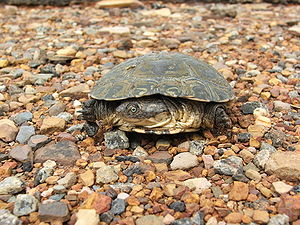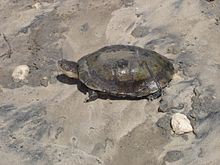Rigid-breasted pelomedus
| Rigid-breasted pelomedus | ||||||||||||
|---|---|---|---|---|---|---|---|---|---|---|---|---|

|
||||||||||||
| Systematics | ||||||||||||
|
||||||||||||
| Scientific name | ||||||||||||
| Pelomedusa | ||||||||||||
| Wagler , 1830 |
The staring-breasted pelomedusa ( Pelomedusa ) are a genus of the turn-neck turtle , which belongs to the family of the Pelomedusidae (Pelomedusidae). They occur from South Africa to Sudan and are the most common and widespread aquatic turtles in southern Africa.
Appearance
Rigid-breasted pelomeduses reach a carapace length of up to 32.5 centimeters and can weigh up to 2.5 kilograms. Females are usually smaller than males and can reach carapace lengths of up to 29.3 centimeters. You then weigh around 2.2 kilograms.
The color of the armor is olive green to brown. The top of the tail and the extremities are gray-brown. The head is broad with a short muzzle. The belly armor is very variable in color. Individual individuals have a completely black belly armor, while others are yellowish horn-colored. Males can be distinguished from females by their longer and thicker tail.
Distribution area and habitat
Rigid-breasted pelomedus are common in much of Africa and the southwest of the Arabian Peninsula. The distribution area extends from Senegal to South Africa and Madagascar . Occasionally they only use existing bodies of water on a temporary basis and can migrate over considerable distances during the rainy season. Rigid-breasted pelomedusas are also found in rivers, although this is not their preferred habitat. They are absent in mountain regions, forests and desert regions.
If the waters they use dry out, the animals dig up to 5 centimeters deep into the ground. Since the dry season in southern Africa usually falls on the African winter months, this is a winter rigor. It often lasts from May to August and occasionally even until October.
Diet
Rigid-breasted pelomeduses are a species of turtle that is bound to the water and is predominantly crepuscular and nocturnal. They prefer to eat fish, tadpoles and frogs, and also go on carrion. Rigid-breasted pelomedusas have been observed plucking ticks from larger mammals such as rhinos that are resting in the water. But they also prey on birds that gather at the watering holes. A captured bird is dragged into the water and drowned there. Ducklings are particularly at risk.
Rigid-breasted pelomeduses also eat vegetable foods such as the roots, leaves and flowers of aquatic plants, as well as fruits. Basically, the food is only eaten in the water.
Reproduction
The breeding season of the rigid-breasted pelomeduses falls in spring. During this time, males follow the females and sniff their tail region. If the female does not respond, the males often snap at the hind legs and tail. When mating, the male climbs onto the back of the female's armor and clings to the armor with the claws of his legs. The head and neck are extended during mating, and the male secretes water from his nostrils during mating.
The clutch comprises 10 to 30 elliptical eggs. The incubation period lasts 90 to 100 days. Newly hatched rigid-breasted pelomeduses measure 2.5 to 3.5 centimeters and still have a visible yolk sac during the first days of life.
Systematics
The first rigid-breasted pelomedusa was described as Testudo subrufa by the French naturalist Pierre Joseph Bonnaterre in 1789 and assigned to the newly established genus Pelomedusa in 1830 by the German zoologist Johann Georg Wagler . The then further described Pelomedusa species were later all synonymous with Pelomedusa subrufa .
Types and distribution
Since the genus was revised in 2014, ten species have been recognized. There are also two more for which an initial scientific description is not yet available.
- Pelomedusa barbata Petzold, Vargas-Ramirez, Kehlmaier, Vamberger, Branch, Du Preez, Hofmeyr, Meyer, Schleicher, Široký & Fritz 2014 ; Southwest of the Arabian Shark Island.
- Pelomedusa galeata (Schoepff, 1792) ; South Africa.
- Pelomedusa hafie (Rüppell, 1835) ; Eritrea, Sudan?
- Pelomedusa kobe Petzold, Vargas-Ramirez, Kehlmaier, Vamberger, Branch, Du Preez, Hofmeyr, Meyer, Schleicher, Široký & Fritz 2014 ; Tanzania.
- Pelomedusa neumanni Petzold, Vargas-Ramirez, Kehlmaier, Vamberger, Branch, Du Preez, Hofmeyr, Meyer, Schleicher, Široký & Fritz 2014 ; western Kenya, northern Tanzania.
- Pelomedusa olivacea (Schweigger, 1812) ; Sahel from Senegal to Niger.
- Pelomedusa schweinfurthi Petzold, Vargas-Ramirez, Kehlmaier, Vamberger, Branch, Du Preez, Hofmeyr, Meyer, Schleicher, Široký & Fritz 2014 ; South Sudan
- Pelomedusa somalica Petzold, Vargas-Ramirez, Kehlmaier, Vamberger, Branch, Du Preez, Hofmeyr, Meyer, Schleicher, Široký & Fritz 2014 ; northwest Somalia.
- Pelomedusa subrufa (Bonnaterre 1789) ; southern Africa from Angola and Namibia to Mozambique and southern Madagascar.
- Pelomedusa variabilis Petzold, Vargas-Ramirez, Kehlmaier, Vamberger, Branch, Du Preez, Hofmeyr, Meyer, Schleicher, Široký & Fritz 2014 ; Ghana, Ivory Coast.
- Pelomedusa Candidate species A; south of Lake Chad.
- Pelomedusa Candidate species B; central sudan.
| Pelomedusa |
|
||||||||||||||||||||||||||||||||||||||||||||||||||||||||||||||||||
|
|
supporting documents
Individual evidence
literature
- Richard C. Boycott, Ortwin Bourquin: The southern African Toirtoise Book - A Guide to southern African Tortoises, Terrapins and Turtles. O. Bourquin, KiwaZulu-Natal 2000, ISBN 0-620-26536-1 .
- A. Petzold, M. Vargas-Ramirez, C. Kehlmaier, M. Vamberger, WR Branch, L. Du Preez, MD Hofmeyr, L. Meyer, A. Schleicher, P. Široký & U. Fritz (2014): A revision of African helmeted terrapins (Testudines: Pelomedusidae: Pelomedusa), with descriptions of six new species. Zootaxa 3795 (5): 523-548 doi: 10.11646 / zootaxa.3795.5.2
